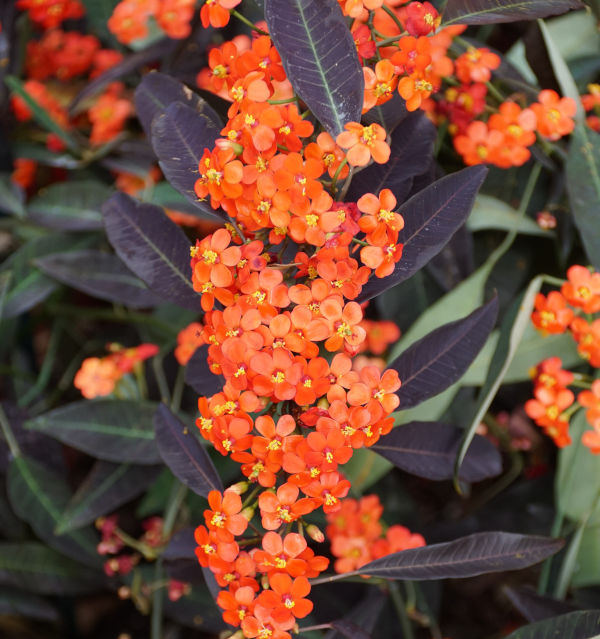How to grow Euphorbia
A large and diverse genus that contains over 2,000 species ranging from tiny annual plants, through to houseplants, perennials, shrubs and even trees which grow to 30m tall!
Euphorbia were first described by Carl Linnaeus, “the father of modern taxonomy” in the 18th century.
Euphorbia are well known to us all even though many of us wouldn’t realise. Even if you aren’t a gardener you may have the red or white bracts of a Poinsettia, Euphorbia pulcherrima, decorating your home during the Christmas period!
All euphorbia contain a milky sap which can be an irritant to skin or eyes and harmful if eaten by humans or pets. Rarely does it cause a problem though exposure to plant consumption in quantity, can cause nausea or diarrhoea. Sap should be washed off with soap and water and eyes rinsed with clean water. When working with these plants its best to wear suitable gloves, clothing and eye protection.
In the wild, specific species of euphorbia are native to most of the world with the exception of Canada, Greenland, Iceland, eastern Siberia and the Antarctica.
In the UK Euphorbia amygdaloides is native, commonly called wood spurge, of which there are several cultivated forms grown for their ornamental value. The common name “spurge” derives from the middle English / old French language to espurge (“to purge”) due to the use of the plants sap as a purgative - laxative.
In the garden euphorbia carry domes of foliage in an array of striking colours often with acid yellow coloured flowers in spring to early summer. Choose a variety that is best suited to your location. Some varieties are evergreen, some are hardier, some are sun lovers whilst other prefer a shadier spot in either moist, yet well drained, or dry poor soils. Most euphorbia provide valuable nectar for pollinating insects.
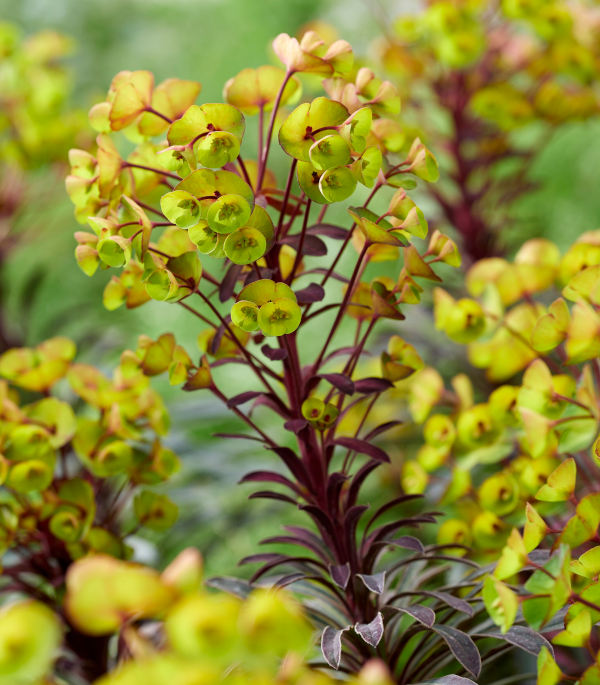
Zantedeschia is a genus of flowering plants from the family Araceae and is native to southern Africa. With a rich history dating back to the Ancient Romans, these deciduous or semi-evergreen perennials have been used as a symbol of celebration. Zantedeschia was Named after Professor Giovanni Zantedeschia, an Italian botanist.
There are two main forms of Zantedeschia: hardy and tender. Hardy forms of the plant can be grown outdoors, enjoy moist soil and full sun or partially shaded conditions - these are known as Arum lilies. Tender forms of Zantedeschia prefer being grown in containers or pots and should be brought inside over the winter - these are known as Calla lilies.
With tuberous flora in all colours from whites, yellows and oranges to deep reds and purples, Zantedeschias are not to be overlooked in any garden, as long as they have sufficient sunlight to grow in.
Ready to learn more about growing Zantedeschia? Read on for all there is to know...

Key Information
Soil pH
Position
Hardiness

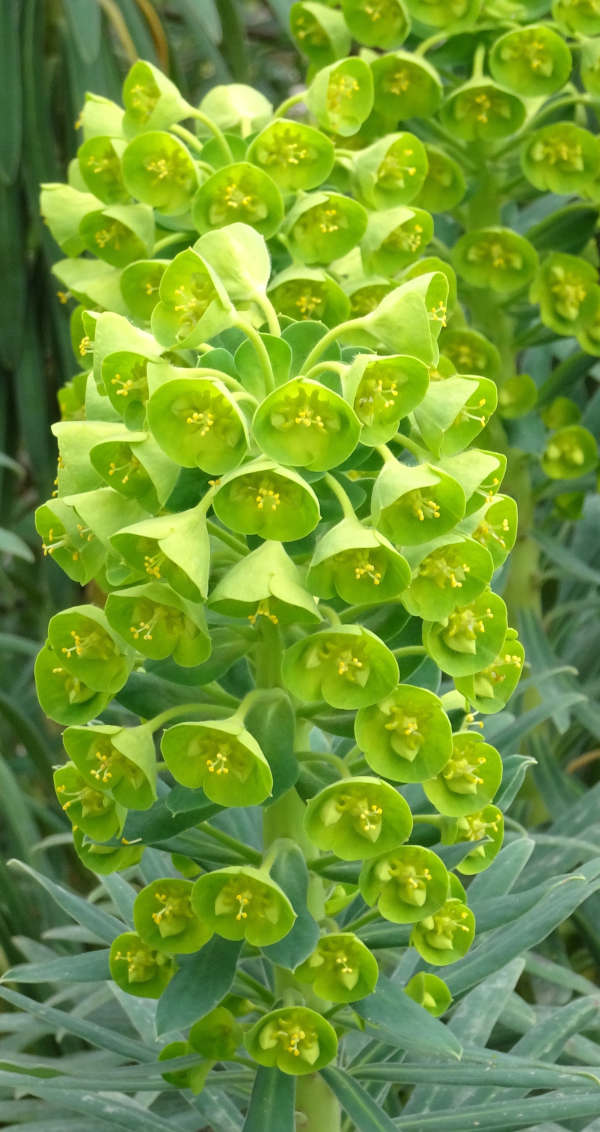
Where & when to plant Euphorbia
Euphorbia can be planted all year around when purchased grown in pots so long as the ground is not frozen or waterlogged.
If container grown plants are planted out during the active summer growing season make sure that they are watered regularly until the plant has settled into its new location. Water at soil level rather than the foliage. Wear protective equipment such as gloves and eye protection when handing for protection against its sap.
There is a euphorbia for almost every location indoor or out and for almost every soil type so check the variety details when purchasing.
Here we list out the most popularly cultivated species and hybrids available in the U.K.
| Species | Common name |
Can be grown outside in the summer H1b (10°C to - 15°C) | Euphorbia milii | Crown of thorns |
Euphorbia pulcherrima | Poinsettia | |
Tolerant of low temperatures, but not surviving being frozen H2 (1°C to 5 °C)
| Euphorbia marginata | Snow on the mountain |
Hardy in coastal and relatively mild parts of the UK H3 (-5 °C to 1 °C) | Euphorbia fulgens | Scarlet Plume |
Hardy through most of the UK H4 (-10°C to -5°C) | Euphorbia ceratocarpa | Horned spurge |
Euphorbia characias | Mediterranean spurge | |
Hardy in most places throughout the UK even in severe winters H5 (-15°C to -10°C) | Euphorbia myrsinites | Broad-leaved glaucous spurge |
Euphorbia peplus | Petty spurge | |
Hardy in all of UK and northern Europe H6 (-20°C to -15°C) | Euphorbia amygdaloides | Wood spurge |
Euphorbia epithymoides. Synonymous Euphorbia polychroma | Cushion spurge | |
Euphorbia esula | Leafy spurge | |
Euphorbia rigida | Upright myrtle spurge | |
Hardy in the severest European continental climates H7 (< -20°C) | Euphorbia cyparissias | Cypress spurge |
Euphorbia griffithii | Spurge | |
Euphorbia helioscopia | Sun spurge |
How to plant Euphorbia
- For garden varieties to be planted in the garden, dig the soil area removing any large stones and weeds and breaking up any lumps. Mix in some organic matter, ideally leaf mould, though manure or garden compost are also fine. Rake level and firm with your heels. Rake level again.
- Water plants well and allow to drain before planting.
- A good tip is to dig a hole twice the size of the root-ball. Fill with water and allow to drain before placing in the plant which is especially good for summer plantings.
- Remove the plant from its pot placing the plant in the hole, ensuring the top of the root ball sits level with the surface of the soil. Too low and the plant may rot, too high and the roots can dry out
- Backfill with soil and firm in gently with your foot.
- Soak soil well with water.
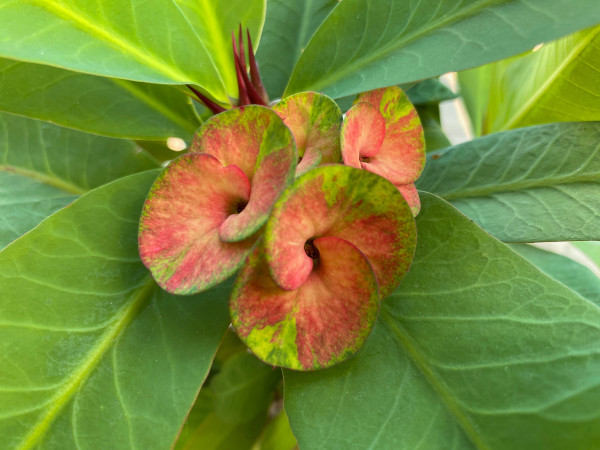
What to plant with Euphorbia
Outdoors, plant alongside plants with different shaped or coloured foliage as a contrast whilst also making sure nearby plants have interest when euphorbia are not in flower.
Try Actaea, Cyclamen, Convallaria, Epimedium, Ferns and Grasses, Galanthus, hardy Geranium, Hosta, Liriope, Trillium, Viburnum.
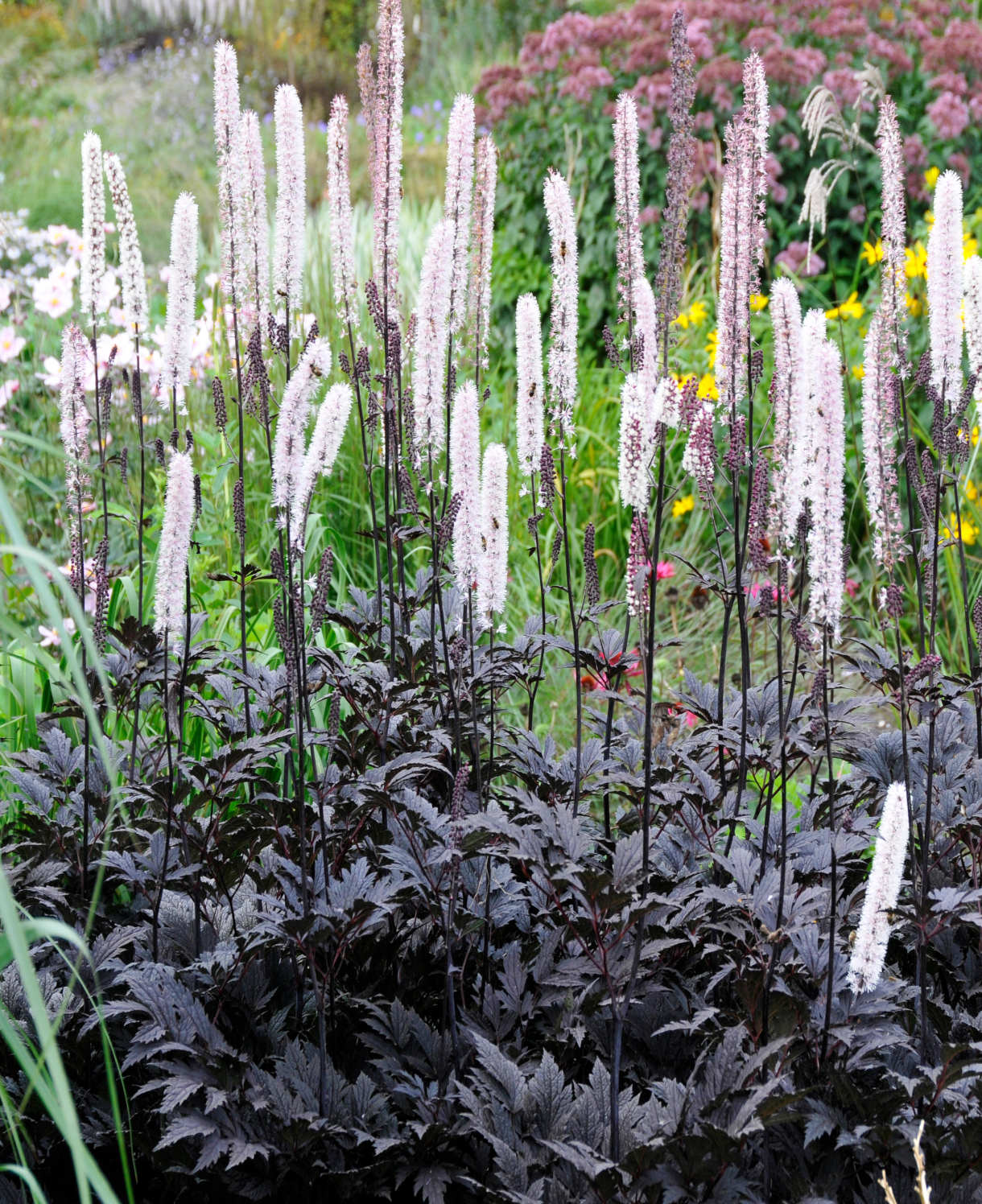

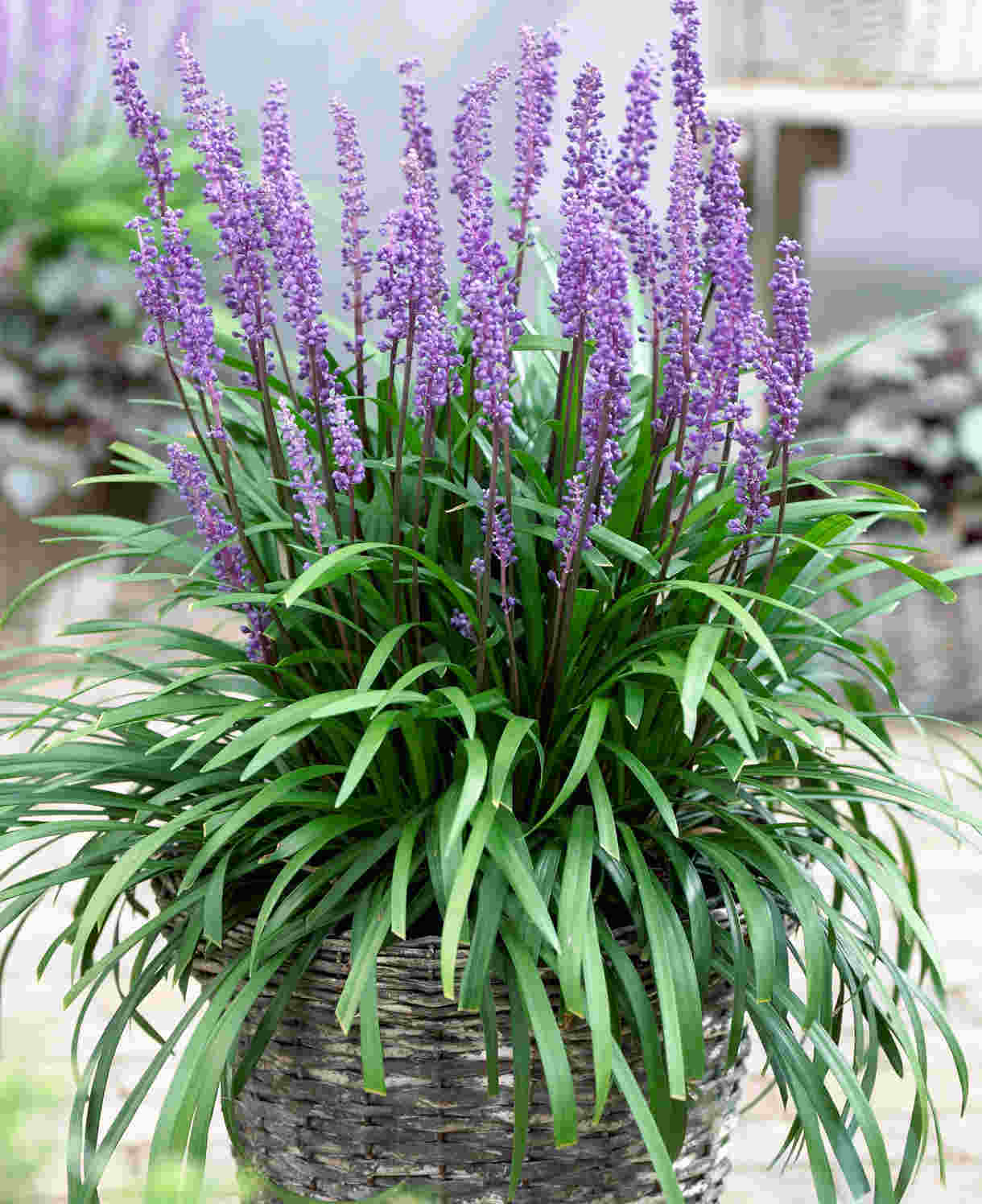
How to care for Euphorbia
Pruning and Deadheading of Garden Varieties
Immediately after flowering has finished remove flowered stems cutting off at the base.
Remove any dead or damaged stems by also cutting off at the base.
*wear gloves and eye protection to avoid contact with sap.
For indoor varieties see specific guide.
Watering
On planting outside, they benefit from a good watering in on planting and then regular soakings until established. After this they shouldn’t need watering.
For container grown plants water regularly to keep moist at all times. Allow the top few centimetres to dry out between soakings is a good rule of thumb to avoid overwatering. To check this, wiggle your finger down into the soil until you hit a cool, damp bit.
Water the soil around the plant rather than its leaves.
Feeding
On healthy, fertile soil, a mulch of well-rotted organic matter (i.e., a layer of leaf mould, manure, or garden compost applied to the soil around the plant) should provide enough nutrients for your euphorbia. This has the added benefit of suppressing weeds and locking in moisture. Mulch when planting, and then again each spring.
If you garden on poor soil or your euphorbia looks in need of a boost apply a granular general purpose feed to the surface of the soil and lightly working in can reap benefits. This is known as a top dress and should be done when you’re mulching in spring – first apply the feed, then cover with the mulch.
Cold Protection
Whether your euphoria needs cold protection or not depends upon the variety of euphorbia you are growing. Check the plant label carefully.
Pests and Diseases
Euphorbia are generally pest and disease free, although can be susceptible to aphid.
How to propagate Euphorbia
The easiest way to propagate garden euphorbia is by root division or basal cuttings which guarantees that the plant is true to type. The Seeds can be sown but can take months to germinate and may not be exactly as its parent.
When your plant is at least 3 years old and has been growing well in the previous season you should be able to divide the root structure into more plants during early spring.
Division
- Make sure the plant is not suffering from drought, pest or disease.
- Lift plants carefully by digging all around its crown with a fork.
- Shake off excess soil so you can clearly see the roots.
- Carefully tease the root ball apart ensuring each stem has a good amount of root growth.
- Pot up each segment individually into pots of good quality compost or plant back into the garden. Hold the growth stem carefully with fingertips of one gloved hand with the other gloved hand backfill the compost around the roots lightly firming in. Ensure the stem is planted at the same depth as before.
- Water well and leave in a light shady spot keeping moist at all times.
- The euphorbia should show signs of further growth within a couple of weeks.
Softwood basal cuttings
- In spring collect some young shoots at the base of the euphorbia. Wearing gloves select shoots which are at least 7-10cm long with leaves unfolding. Wearing gloves to protect from sap and using a sharp knife cut as close to the base as possible including part of the woody basal tissue.
- Using a sharp knife trim below a node (leaf joint) Remove the lower sets of leaves leaving 2 to 4 leaves at the top.
- Pinch out the soft tip to just above a leaf joint and dip the base into rooting hormone powder or liquid.
- In a ready watered and drained pot level filled and lightly firmed with good quality new compost, make a hole for the cutting with a dibber. Insert the base of the cutting until the first set of leaves are just above the surface.
- In a 9cm pot you can put 3 cuttings in a triangular formation making sure the leaves are well within the edges of the pot.
- Covering with a plastic sandwich- like-bag to form a mini propagator is a good idea for the first few weeks. Hold the bag in place on the pot with an elastic band or string. Ensure the bag is stiff enough to hold upright above the plants foliage. The plastic bag holds in moisture keeping the humidity high which reduces the rate of water loss from the cutting, increasing the success rate of propagation.
- Place the pot on a saucer away from direct sunlight, yet in a light area that is around 18-24oC.
- At least twice a week remove the bag to allow some ventilation to the cuttings for 15 minutes. Check the soil surface feels damp.
- Rooting takes 2 to 4 weeks. Gently pull on one of the cuttings if it shows resistance then it is likely roots are forming. The bag can now be removed for longer periods of time gradually acclimatising the cuttings to their surroundings. (Hardening Off)
- Remove any dead or decaying material regularly.
- Once hardened off for 2 -4 weeks the cuttings should be ready for potting on individually. Carefully remove the plants from the pot as one root ball. Checking for signs of good rooting - if not ready, leave to develop for few more weeks. Carefully separate each cutting ensuring a good portion of root is kept intact potting on into individual 9cm pots. Water well and leave to develop in a light sheltered environment until established.
* Many plants carry Plant Breeders Rights and cannot be propagated for commercial purposes.
**wear suitable protection to avoid sap coming into contact with skin and eyes.
Common Euphorbia questions
How do you grow Euphorbia fast?
Why would you want to grow euphorbia fast? If its to fill a gap in your garden then make sure you select one of the many varieties that fits your location and soil type. The plant will be fit for purpose.
Where do Euphorbia like to be planted?
There is a euphorbia for almost every location and aspect. When choosing which variety to buy, check the plant label or growing instructions. Some prefer shade, some prefer sun, some like dry soils whilst others like moist conditions.
Can Euphorbia be grown from cuttings?
Yes euphorbia can be grown from basal cuttings in spring.
